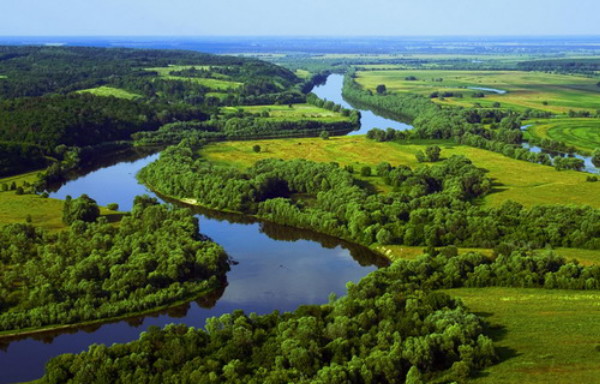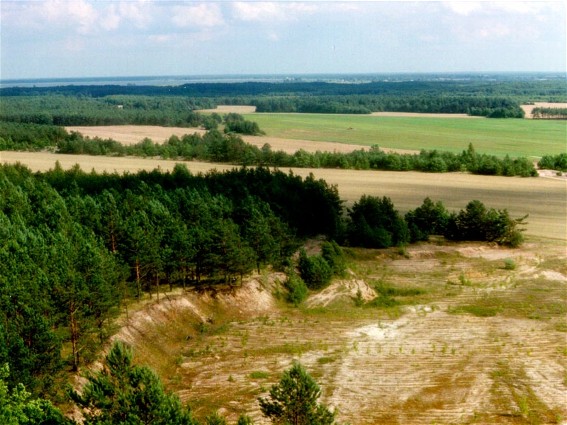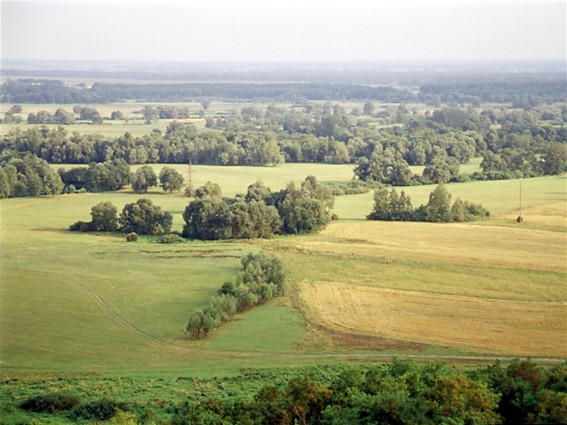Forest-steppe
Forest-steppe [лісостеп; lisostep]. A natural belt characterized by the alternation of forests—mostly deciduous—with steppe vegetation and fauna.
In Ukraine the forest-steppe is the central belt stretching between the forest belt in the north and the steppe belt in the south. It is part of the Eastern European forest-steppe and covers about 30 percent of Ukraine's territory. The boundary with the forest belt (Polisia) runs along the line Lviv–Kremenets–Zhytomyr–Kyiv–Nizhyn–Hlukhiv and is distinct. Generally, it coincides with the northern limits of the loess and chornozem soils. Northwest of the main forest-steppe belt lies a large forest-steppe island called the Volhynia–Kholm forest-steppe (north of the line Kholm–Lutsk–Zhytomyr). In the west the forest-steppe borders on a belt of forests of the Central European variety, covering Roztochia, the Sian Lowland, Subcarpathia, and the Opilia Upland. Soviet authorities classified these territories as forest-steppe. The southern border of the forest-steppe is not as distinct and is defined in different ways, usually by the line Chişinau–Kropyvnytskyi–Krasnohrad–Zmiiv–Valuiky–Buturlynivka.
The Ukrainian forest-steppe is a gently undulating plain, covered for the most part by a thick, loess stratum that overlies various geological layers dissected by gullies and ravines. An erosive-ravine landscape, in particular a ravine-gully, plate, and granite landscape, is characteristic of this belt. The forest-steppe covers the Volhynia-Podilia Upland, the Dnipro Upland, the Central Upland, and partially the Dnipro Lowland. A warm summer and a moderately cold winter are characteristic of the forest-steppe. The climate becomes more continental towards the east; the average July temperature is 18°C in the west and 20°C in the east, while the average January temperatures are –4°C and –8°C. The number of days above 0°C is 230 in the northeast and 270 in the southwest. The number of days above 5°C is 190 and 220. Annual precipitation is usually 450–550 mm in the east and 550–700 mm in the west. Eighty percent of the precipitation falls when the temperature is above 0°C. In the summer the rain comes in downpours. The main soils of the belt are deep chornozems and high-humus chornozems (particularly in the southern regions), some of which have been degraded into podzolized and meadow chornozems and gray podzol soils under the influence of forests.
Originally, forests covered one-quarter to one-third of the territory of the forest-steppe, and even more in the west. Now they cover only 11 percent of the territory. Because of deforestation and plowing, rainfall and snow run off quickly (more than half of the river water comes in the spring) and cause erosion and loss of topsoil, particularly in Left-Bank Ukraine. Today forests usually cover the sloping right banks of rivers, gullies, and ravines and the hilly watersheds. The oak is the most common tree (found in almost half of the belt). Ash, maple, elm, linden, and other varieties are found alongside the oak. Hornbeam grows west of the Dnipro River, and beech only in western Podilia. Pine forests and plants associated with those in Polisia are found on the Left-Bank terraces, particularly on the left-bank of the Dnipro. The undergrowth usually consists of hazelnut, alder, buckthorn, spindletree, wayfaring tree, hawthorn, blackthorn, and thelycrania. The ground cover consists of fir, asarum, asperula, broad-leaved snail clover, mercurialis, anemone, cynosurus, and certain varieties of fern. Beech, beech-hornbeam, hornbeam, hornbeam-oak, and oak forests grow in the westernmost part of the forest-steppe, which is also the most forested part. Oak and hornbeam-oak forests are found in eastern Podilia and in Right-Bank Ukraine. Oak and oak-linden forests predominate in Left-Bank Ukraine. The steppe part of the forest-steppe (now under cultivation) is classified as a grassy, colored, broad-leaved steppe. The following meadow-steppe vegetation is characteristic of it: feather grass, fescue, meadow sage, pedicularis, and so on. The fauna is a mixture of forest species (eg, squirrel, marten, rabbit, bobcat, fox, deer, otter, woodpecker, woodcock, pigeon, and turtledove) and steppe species (eg, spotted ground squirrel, mole rat, gray hamster, gray vole, polecat, great bustard and little bustard).
Because of its favorable natural conditions, the forest- steppe was the earliest settled belt in Ukraine and is the most populated (apart from the recent industrial and mining centers). Hence, it is largely deforested and under cultivation. Sixty-eight percent of the land is tilled, 10 percent is pastures and hayfields, and 11 percent is forest (11 percent is other). Forests become fewer towards the east (ranging from 19 percent to 6 percent) while tilled land increases (ranging from 56 percent to 72 percent). For every 100 ha, 54 are devoted to grain, 12 to industrial crops, 10 to potatoes and squash (16 in the west, 7 in the east), 20 to fodder crops, and 4 are kept fallow (0.5 in the west, 8 in the Central Upland). Grain growing and animal husbandry are most intense in the forest-steppe belt. Two-thirds of the grain cultivated is made up of winter wheat and corn. The most important industrial crops are sugar beets (8 percent of the tilled land and three-quarters of the land devoted to sugar beets in Ukraine), and tobacco (44 percent of the land devoted to tobacco in Ukraine) and makhorka (88 percent).
A part of the Central European forest-steppe, which covers the Pannonian Lowland, extends into Ukraine and occupies the Tysa Lowland, the northern slopes of the Crimea, and Subcaucasia.
BIBLIOGRAPHY
Tutkovs’kyi, P. Pryrodna raionizatsiia Ukraïny (Kyiv 1922)
Berg, L. Geograficheskie zony Sovetskogo Soiuza, 3rd edn (Moscow 1947)
Mil’kov, F. Lesostep' Russkoi ravniny (Moscow 1950)
Atlas sil’s’koho hospodarstva Ukraïns’koï RSR (Kyiv 1958)
Chyzhov, M. Ukraïns’kyi lisostep (Kyiv 1961)
Volodymyr Kubijovyč
[This article originally appeared in the Encyclopedia of Ukraine, vol. 1 (1984).]



